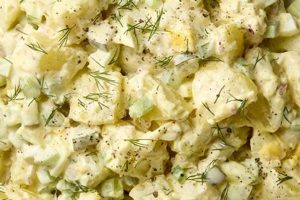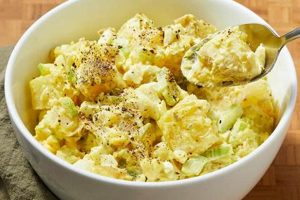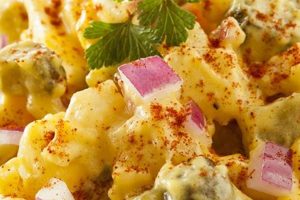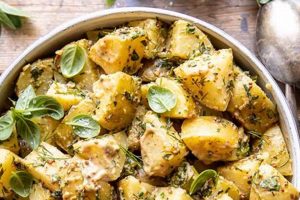A guide to preparing this traditional dish typically involves boiled starchy potatoes, combined with a vibrant blend of ingredients. This often includes mayonnaise, hard-boiled eggs, olives, onions, peppers, and spices like adobo and cilantro, contributing to its distinct flavor profile. Variations may incorporate ingredients such as ham, capers, or pimientos, reflecting regional or family preferences.
This dish holds cultural significance as a staple side at Puerto Rican celebrations and family gatherings. Its creamy texture complements a range of main courses, from roasted meats to fried plantains. The blend of savory and tangy elements provides a refreshing counterpoint to richer dishes, enhancing the overall dining experience. Its enduring popularity stems from the accessible ingredients and relative ease of preparation, allowing it to be adapted and enjoyed across generations.
This exploration will delve into variations of this classic dish, offering detailed instructions for preparation, highlighting ingredient selection, and showcasing techniques for achieving optimal flavor and texture. Further insights into the cultural context and suggested pairings will enrich the understanding and appreciation of this beloved Puerto Rican side dish.
Tips for Crafting Exceptional Puerto Rican Potato Salad
Achieving the perfect balance of flavors and textures in this classic dish relies on attention to detail throughout the preparation process. These tips offer guidance for elevating the final product.
Tip 1: Potato Selection and Preparation: Opt for starchy potatoes like Yukon Gold or russet for optimal creaminess. Dice potatoes into uniform sizes to ensure even cooking. Avoid overboiling, as this can result in a mushy texture. Cool potatoes completely before combining with other ingredients to prevent mayonnaise from separating.
Tip 2: Enhancing the Dressing: While mayonnaise forms the base, adding a touch of olive oil can create a richer, smoother consistency. A splash of vinegar or lime juice introduces a subtle tang that balances the richness.
Tip 3: Building Flavor Complexity: Adobo seasoning is crucial for authentic flavor. Fresh cilantro adds brightness, while finely diced onions and peppers provide a satisfying crunch. Experiment with additions like capers, olives, or pimientos for nuanced complexity.
Tip 4: Hard-Boiled Egg Perfection: Properly cooked hard-boiled eggs enhance both flavor and visual appeal. Avoid overcooking, which can cause the yolks to turn green. Cool eggs rapidly after cooking to prevent a sulfurous odor.
Tip 5: Chilling and Serving: Allowing the salad to chill for at least an hour before serving allows the flavors to meld. Garnish with fresh cilantro or a sprinkle of paprika for an elegant presentation.
Tip 6: Adapting to Preferences: This dish lends itself to customization. Incorporating cooked ham, bacon, or chickpeas can add protein and texture. Adjusting the amount of mayonnaise or spices allows for tailoring to individual taste preferences.
By following these tips, one can create a flavorful and authentic representation of this cherished dish, guaranteed to impress at any gathering.
These insights provide a solid foundation for crafting a truly exceptional rendition of this Puerto Rican staple, paving the way for a satisfying culinary experience.
1. Starchy Potatoes (Yukon Gold, Russet)
Starchy potatoes play a crucial role in achieving the desired texture and flavor profile of authentic Puerto Rican potato salad. Their relatively high starch content and low moisture level contribute to a creamy, less waxy consistency compared to other potato varieties. This characteristic is essential for absorbing the dressing and seasonings without becoming overly mushy.
- Textural Contribution:
The high starch content of Yukon Gold and russet potatoes allows them to absorb the dressing effectively, creating a creamy, cohesive salad. Waxy potatoes, on the other hand, tend to retain their shape and resist absorbing flavors, resulting in a less desirable texture for this particular dish.
- Flavor Absorption:
Starchy potatoes readily absorb the flavors of the adobo, olive oil, vinegar, and other seasonings present in the dressing, ensuring a well-seasoned and flavorful salad. Their neutral flavor profile serves as an excellent canvas for the other ingredients to shine.
- Visual Appeal:
When cooked properly, starchy potatoes maintain their shape while developing a soft, fluffy interior. This contributes to the appealing visual presentation of the salad, with distinct pieces of potato coated in the vibrant dressing.
- Cultural Significance:
While specific potato varieties may vary based on availability and regional preferences, the use of starchy potatoes in Puerto Rican potato salad aligns with the traditional emphasis on a creamy, well-seasoned dish. This choice reflects a deep understanding of the interplay between ingredients and the desired outcome.
The selection of starchy potatoes like Yukon Gold or russet is not merely a matter of convenience; it’s a deliberate choice that significantly influences the overall quality and authenticity of the dish. Their unique properties contribute to the creamy texture, flavor absorption, and visual appeal that define a well-executed Puerto Rican potato salad.
2. Mayonnaise-based dressing
Mayonnaise forms the foundation of the dressing in Puerto Rican potato salad, contributing significantly to its characteristic creamy texture and rich flavor profile. Understanding the role of mayonnaise and its interaction with other ingredients is crucial for achieving the desired balance and authenticity.
- Binding Agent:
Mayonnaise acts as the primary binding agent, holding the various ingredients together. Its emulsified nature allows it to coat the potatoes and other components, creating a cohesive salad that maintains its structure. This binding quality ensures that the flavors meld and the salad presents well.
- Flavor Foundation:
The tangy, rich flavor of mayonnaise provides a base upon which other flavors build. It complements the savory notes of adobo and other spices, while also balancing the acidity from vinegar or lime juice. The inherent creaminess of mayonnaise enhances the overall sensory experience.
- Texture and Mouthfeel:
Mayonnaise contributes significantly to the creamy, smooth texture that distinguishes this potato salad. It coats the potatoes, creating a luxurious mouthfeel that contrasts with the crunch of onions and peppers, adding to the overall enjoyment of the dish.
- Variations and Adaptations:
While traditional recipes rely primarily on mayonnaise, variations may incorporate other elements such as olive oil or sour cream to adjust the richness and tanginess. These adaptations allow for customization while retaining the essential creamy element that defines the dish.
The mayonnaise-based dressing is not merely a functional component; it is integral to the identity of Puerto Rican potato salad. Its binding properties, flavor contribution, and textural influence work in harmony with the other ingredients, creating a balanced and flavorful dish that embodies the culinary traditions of Puerto Rico. The careful selection and preparation of the mayonnaise-based dressing are essential steps in achieving an authentic and satisfying result.
3. Hard-boiled eggs
Hard-boiled eggs constitute an essential element in Puerto Rican potato salad, contributing not only to its visual appeal but also to its textural and flavor complexity. Their inclusion elevates the dish beyond a simple potato salad, adding a layer of richness and substance characteristic of this traditional recipe.
- Textural Contrast:
The firm, yet yielding texture of hard-boiled eggs offers a pleasant contrast to the creamy potatoes and the smoothness of the mayonnaise-based dressing. This interplay of textures creates a more dynamic and satisfying sensory experience. The slight chewiness of the egg white and the crumbly texture of the yolk provide textural variation within each bite.
- Flavor Enhancement:
The subtly savory flavor of hard-boiled eggs complements the other ingredients in the salad. The yolk, in particular, adds a richness that harmonizes with the tangy mayonnaise and savory spices. This nuanced flavor profile contributes depth and complexity to the overall taste.
- Visual Appeal:
The bright white and yellow of hard-boiled eggs create visual interest within the salad. The pieces of egg, often diced or sliced, provide a contrasting color and shape against the backdrop of the potatoes and other ingredients. This visual element enhances the presentation and makes the salad more appealing.
- Nutritional Value:
Beyond flavor and texture, hard-boiled eggs contribute nutritional value to the dish. They are a good source of protein and essential nutrients, adding a healthy component to this classic side dish. This nutritional contribution further enhances the value of hard-boiled eggs within the recipe.
The inclusion of hard-boiled eggs in Puerto Rican potato salad is a defining characteristic, enriching the dish in terms of texture, flavor, visual presentation, and nutritional content. Their presence elevates the salad from a simple side to a more complex and satisfying culinary experience, reflecting the attention to detail and balanced flavors inherent in Puerto Rican cuisine. This seemingly simple addition plays a crucial role in shaping the overall character and enjoyment of this beloved dish.
4. Savory Spices (Adobo)
Adobo seasoning serves as a cornerstone of Puerto Rican culinary tradition, deeply intertwined with the distinct flavor profile of the island’s potato salad. This blend of spices, typically composed of salt, pepper, garlic powder, onion powder, oregano, turmeric, and sometimes cumin, infuses the dish with a savory depth crucial for its authentic character. Adobo’s presence goes beyond mere seasoning; it embodies the essence of Puerto Rican flavor, distinguishing this potato salad from other variations. The complex interplay of spices within adobo creates a foundation upon which other flavors build, enhancing the overall culinary experience. For instance, the warmth of oregano and the earthiness of turmeric complement the creamy potatoes and tangy mayonnaise, creating a harmonious balance of flavors. Omitting adobo results in a bland, less authentic representation of the dish, highlighting its essential role.
The importance of adobo in Puerto Rican potato salad extends beyond its flavor contribution. It represents a cultural connection, reflecting the island’s rich culinary heritage. The consistent use of adobo across generations solidifies its place as a staple ingredient, signifying a shared culinary identity. This cultural significance adds another layer of depth to the dish, making it more than just a side item; it becomes a symbol of tradition and family. Furthermore, the versatility of adobo allows for adaptation and personalization. While pre-mixed versions offer convenience, individual cooks often customize their blends, adding or adjusting spices to suit family preferences. This adaptability ensures that the tradition remains alive while accommodating individual tastes. One might add a touch of smoked paprika for a deeper smoky flavor or increase the amount of garlic powder for a more pungent aroma, reflecting the dynamic nature of culinary traditions.
Understanding the integral role of adobo provides a key insight into the essence of Puerto Rican potato salad. It underscores the importance of spice blends in shaping culinary identity and demonstrates the power of seemingly simple ingredients to elevate a dish beyond its basic components. Recognizing this connection allows for a deeper appreciation of the cultural and culinary significance of this traditional dish. Mastering the use of adobo empowers individuals to create an authentic and flavorful representation of Puerto Rican potato salad, honoring its heritage and sharing its unique taste with others. While challenges may arise in sourcing specific ingredients or adapting to regional variations, the core principle remains: adobo is the heart of authentic Puerto Rican potato salad.
5. Fresh Cilantro
Fresh cilantro plays a vital role in Puerto Rican potato salad, contributing a bright, herbaceous element that balances the richness of the mayonnaise and the savory spices. Its distinctive flavor and aroma are integral to the overall sensory experience, distinguishing this dish from other potato salad variations. Understanding cilantro’s contribution is key to appreciating the complexity and authenticity of this traditional recipe.
- Flavor Profile:
Cilantro possesses a unique, citrusy, slightly peppery flavor that adds a refreshing counterpoint to the richness of the mayonnaise-based dressing. This brightness cuts through the heavier elements, preventing the salad from becoming overly dense or cloying. The herbaceous notes complement the savory spices, creating a balanced and complex flavor profile.
- Aromatic Enhancement:
Beyond its flavor contribution, fresh cilantro imparts a vibrant aroma that enhances the overall sensory experience. The distinctive scent, released when the leaves are chopped or torn, adds another layer of complexity to the dish, stimulating the appetite and adding to the enjoyment of the meal. This aromatic element further distinguishes Puerto Rican potato salad from other variations.
- Visual Appeal:
The bright green color of fresh cilantro provides a visually appealing contrast to the creamy white of the potatoes and mayonnaise. This pop of color enhances the presentation of the salad, making it more inviting and appetizing. The delicate, feathery leaves also add textural interest.
- Cultural Significance:
The use of fresh cilantro reflects the broader culinary landscape of Puerto Rico, where fresh herbs and spices play a prominent role. Its inclusion in potato salad reinforces the emphasis on fresh, vibrant flavors that characterize the island’s cuisine. This ingredient speaks to the cultural heritage and culinary traditions embedded within the dish.
The inclusion of fresh cilantro is not merely a decorative afterthought; it is an essential component that contributes significantly to the flavor, aroma, visual appeal, and cultural authenticity of Puerto Rican potato salad. Its presence elevates the dish, transforming it from a simple side to a more complex and flavorful culinary experience. Understanding cilantros role provides a deeper appreciation for the nuanced flavors and cultural significance of this traditional Puerto Rican dish. Substituting dried cilantro or other herbs fails to capture the same freshness and vibrancy, underscoring the importance of using fresh cilantro for an authentic representation.
6. Optional additions (olives, peppers)
While the core ingredients of Puerto Rican potato salad establish its foundation, optional additions such as olives and peppers introduce opportunities for personalized flavor and textural enhancements. These additions, while not strictly mandatory, contribute to the dish’s versatility and allow for regional or individual variations, reflecting the dynamic nature of culinary traditions. Exploring these optional components provides insight into the adaptable nature of this classic dish.
- Flavor Complexity:
Olives, whether green, black, or stuffed, introduce a salty, briny element that complements the overall flavor profile. Different varieties offer nuances in taste, allowing for customization based on preference. Peppers, ranging from mild bell peppers to spicy jalapeos or pimientos, contribute a vegetal sweetness or a fiery kick, adding depth and complexity. The interplay of these flavors enhances the overall sensory experience, demonstrating how seemingly simple additions can elevate the dish.
- Textural Variation:
The firm texture of olives provides a pleasant contrast to the creamy potatoes and soft hard-boiled eggs. The crispness of peppers, whether raw or roasted, adds another layer of textural variation, creating a more dynamic mouthfeel. This interplay of textures enhances the enjoyment of the salad, making each bite a multi-sensory experience. The choice of ingredients influences the overall textural profile, allowing for customization based on individual preferences.
- Visual Interest:
The vibrant colors of olives and peppers contribute visual appeal, enhancing the presentation of the salad. Green olives, red pimientos, or brightly colored bell peppers add pops of color against the creamy backdrop of the potatoes and mayonnaise. This visual element makes the dish more inviting and appetizing, elevating it beyond a simple side dish to a more visually engaging culinary creation.
- Regional and Family Variations:
The inclusion of optional ingredients like olives and peppers often reflects regional or family traditions. Certain regions may favor specific types of olives or peppers, adding a unique local touch to the recipe. Families may also have their own preferred combinations, passed down through generations. These variations highlight the adaptability of the dish and its capacity to reflect individual tastes and cultural influences. For example, a family might always add chopped pimientos, while another prefers the brininess of Kalamata olives, showcasing the personalized nature of these additions.
The incorporation of optional ingredients such as olives and peppers demonstrates the adaptability and evolving nature of Puerto Rican potato salad. These additions, while not essential to the core recipe, provide opportunities for customization, reflecting individual preferences and regional influences. They contribute not only to the flavor and textural complexity but also to the visual appeal and cultural significance of the dish, solidifying its place as a versatile and beloved culinary tradition. Understanding the role of these optional elements allows for a deeper appreciation of the dishs dynamic character and its ability to accommodate a range of tastes and traditions.
7. Chilling Time
Chilling time is a crucial step in preparing Puerto Rican potato salad, significantly impacting the final dish’s flavor development and overall quality. This period of refrigeration allows the diverse flavors of the ingredients to meld and harmonize, creating a more cohesive and balanced taste profile. Understanding the importance of chilling time is essential for achieving an authentic and satisfying culinary experience.
- Flavor Enhancement:
Chilling allows the flavors of the individual ingredients, such as the potatoes, mayonnaise, adobo seasoning, and fresh cilantro, to meld and deepen. The absorption of the dressing by the potatoes is enhanced during chilling, resulting in a more flavorful and uniform taste throughout the salad. This melding of flavors creates a more complex and nuanced profile compared to a freshly made, unchilled salad.
- Texture Improvement:
Chilling firms the potatoes, improving the overall texture of the salad. This allows the potatoes to hold their shape better, preventing them from becoming mushy or disintegrating when mixed with the other ingredients. The chilling process also enhances the creaminess of the mayonnaise-based dressing, contributing to a more desirable mouthfeel.
- Food Safety:
Chilling helps maintain the safety of the potato salad by inhibiting bacterial growth. Mayonnaise-based salads are particularly susceptible to bacterial contamination, especially at room temperature. Proper chilling, typically to a temperature below 40F (4C), significantly reduces this risk and ensures the salad remains safe for consumption. This aspect is crucial for preventing foodborne illnesses.
- Serving Temperature:
Chilling the potato salad brings it to an ideal serving temperature. A cold potato salad offers a refreshing contrast to other dishes, particularly in warmer climates. The chilled temperature enhances the creamy texture and bright flavors, making it a more enjoyable culinary experience. Serving temperature plays a significant role in the overall perception and enjoyment of the dish.
The chilling period in a Puerto Rican potato salad recipe is not merely a matter of convenience; it’s a deliberate step that significantly contributes to the dish’s overall quality and enjoyment. By allowing the flavors to meld, textures to firm, and ensuring food safety, chilling elevates this traditional side dish to a more refined and satisfying culinary experience. The interplay of these factors highlights the essential role of chilling time in crafting an authentic and delicious Puerto Rican potato salad.
Frequently Asked Questions
This section addresses common inquiries regarding the preparation and characteristics of authentic Puerto Rican potato salad, offering clarity and guidance for achieving optimal results.
Question 1: What type of potatoes are best suited for this recipe?
Starchy potatoes, such as Yukon Gold or russet, are preferred due to their ability to absorb the dressing and create a creamy texture. Waxy potatoes are generally not recommended as they tend to retain their shape and may result in a less desirable texture.
Question 2: Can the mayonnaise be substituted with a lighter alternative?
While traditional recipes utilize mayonnaise, some variations incorporate plain yogurt or a mixture of mayonnaise and yogurt to reduce the overall fat content. However, this substitution may alter the characteristic richness and texture of the traditional dish.
Question 3: Is adobo seasoning essential for authentic flavor?
Adobo seasoning is considered a cornerstone of authentic Puerto Rican potato salad. It provides a distinct savory depth that distinguishes this dish from other variations. While homemade blends offer flexibility, commercially available adobo seasoning provides a convenient alternative.
Question 4: How long should the potato salad be chilled before serving?
Chilling for at least one hour, and preferably longer, allows the flavors to meld and the potatoes to absorb the dressing fully. This also ensures food safety by inhibiting bacterial growth.
Question 5: Can other vegetables be added to the salad?
While traditional recipes focus on a core set of ingredients, variations may include other vegetables such as diced carrots, celery, or red onion. However, it is essential to maintain a balance of flavors and textures to preserve the dish’s authenticity.
Question 6: How long can the potato salad be stored in the refrigerator?
Properly stored in an airtight container, Puerto Rican potato salad can typically be refrigerated for up to three days. Beyond this timeframe, the quality and safety of the salad may be compromised.
Addressing these frequently asked questions provides a comprehensive understanding of the key elements that contribute to a successful and authentic Puerto Rican potato salad. Careful attention to these details ensures a flavorful and enjoyable culinary experience.
This information provides a foundation for navigating the nuances of this traditional dish and achieving a satisfying outcome. Further exploration into regional variations and personalized adaptations can enhance one’s appreciation of this versatile culinary tradition.
Recipe for Puerto Rican Potato Salad
This exploration has provided a comprehensive overview of the essential elements that define a truly authentic Puerto Rican potato salad. From the careful selection of starchy potatoes to the nuanced blend of adobo seasoning and the refreshing brightness of fresh cilantro, each component contributes to the dish’s distinctive character. The importance of chilling time for optimal flavor development and the potential for personalized additions like olives and peppers further enrich the understanding of this versatile culinary tradition. The frequently asked questions section addressed common inquiries, providing clarity and guidance for successful preparation.
This examination underscores the significance of this dish within Puerto Rican culture, highlighting its role in family gatherings and celebrations. More than just a side dish, Puerto Rican potato salad embodies a culinary heritage, reflecting the island’s rich history and vibrant flavors. Continued exploration and appreciation of such traditional recipes ensures the preservation of cultural identity and culinary artistry for generations to come. The provided insights empower individuals to recreate this cherished dish, fostering a deeper connection to Puerto Rican culinary traditions and sharing its unique flavors with others.






